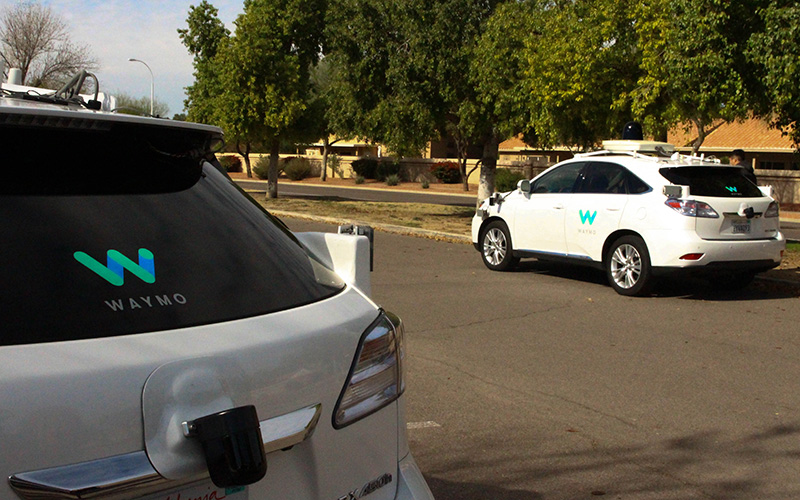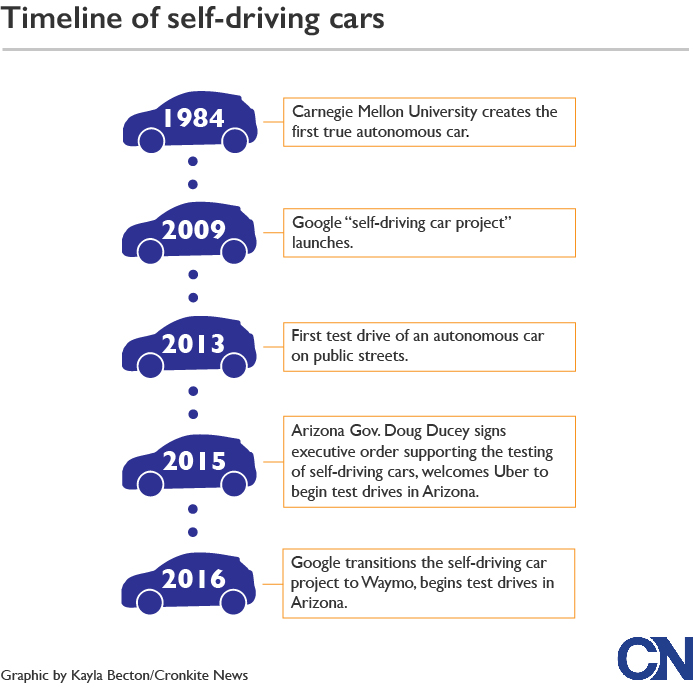CHANDLER – Could a baby in a car seat today be part of the first generation that might never touch a steering wheel?
Automakers and tech companies have been working to make that a reality.
And several – including Ford Motor Co., General Motors Co., Waymo and Uber – are testing their driverless cars in Arizona.
Company officials have said they want to make the roads a safer place. And one local futurist predicts they will eventually eliminate the need for traffic signs and lights on roadways.
Waymo, previously called the Google self-driving car project, has been testing its technology in Chandler since April.
During a recent test drive, Jaime Waydo, lead systems engineer, said it’s encouraging that so many companies have committed to the effort.

Waymo has been testing its self-driving cars in Chandler for nine months. (Photo by Erica Apodaca/Cronkite News)
“We started this eight years ago, and no one was working on it,” Waydo said. “It’s really validating that so many people are working on it, it means that other people believe that this is the safest way to (navigate the) streets.”
Waydo said their vehicles have been involved in two accidents since they began test driving in Chandler, but other motorists caused both crashes. A drunk driver caused one, and a motorist ran a red light in the other.
Residents might recognize the company’s Lexus RX 450h models driving around town by their distinct sensors on top of the cars. During a test drive, the driver didn’t even have his hands on the steering wheel, although he could have taken over if needed.
Last month, Waymo released self-driving Chrysler minivans to test drive in Chandler along with its Lexus models. Waydo said the vehicle is equipped with sensing technology that makes it “the most capable self-driving car in the world.”
Waymo has been test driving autonomous cars in Mountain View, California, since 2009, and it has expanded its testing to several other states. Waymo has collectively test driven 2.5 million miles, which is the equivalent to 300 years of driving experience, Waydo said.

(Sources: Carnegie Mellon University, Waymo, TechAZ, USA Today)
Waymo could not estimate when its driverless cars would be available to the public.
“Our big focus is to pull the driver completely out and get these in the hands of everyone as soon as possible,” Waydo said.
Author Brian David Johnson, Arizona State University’s “Futurist in Residence,” said the current car seat generation and on will have a completely different perception of human drivers.
However, it’s going to take a while.
Johnson said most people tell him they’re scared by the idea of riding in one.

In Waymo’s self-driving car, the display inside the vehicle shows other vehicles and obstacles in the road. (Photo by Erica Apodaca/Cronkite News)
“Early on, maybe eight years ago when I started talking to people about self-driving cars, they were horrified by it,” Johnson said. “They would ask me questions that were basically similar to the robot apocalypse – that they were losing their freedom and that they were losing control, and what happens when self-driving cars all take control and we no longer have control?”
Johnson predicts it will be another eight to 10 years until autonomous cars are more widespread and culturally accepted. He also said children born 50 years from now might not even know what a stoplight is since autonomous cars would take away the need for them.
“It is the children who have never known a time when the car wasn’t actively trying to keep them safe,” Johnson said. “For that generation, they’re going to be the ones who would ask themselves, ‘Why would you ever let a human drive the car?'”